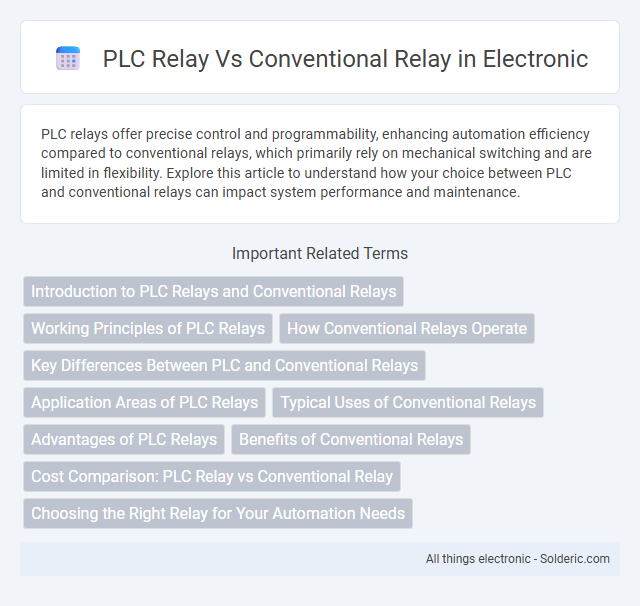PLC relays offer precise control and programmability, enhancing automation efficiency compared to conventional relays, which primarily rely on mechanical switching and are limited in flexibility. Explore this article to understand how your choice between PLC and conventional relays can impact system performance and maintenance.
Comparison Table
| Feature | PLC Relay | Conventional Relay |
|---|---|---|
| Functionality | Programmable logic control, automated switching | Manual or fixed switching based on input signals |
| Control Type | Digital and programmable | Electromechanical switching |
| Flexibility | High; easily reprogrammed for different tasks | Low; fixed wiring and function |
| Application | Industrial automation, complex control systems | Simple switching tasks, basic control circuits |
| Response Time | Fast and precise | Slower due to mechanical movement |
| Durability | Long lifespan with minimal wear | Mechanical parts prone to wear and tear |
| Cost | Higher initial investment | Lower upfront cost |
| Maintenance | Low; software updates only | Higher; regular mechanical maintenance required |
Introduction to PLC Relays and Conventional Relays
PLC relays are specialized components designed for programmable logic controllers, offering precise control and automation in industrial processes. Conventional relays are electromechanical switches that operate using an electromagnetic coil to open or close contacts, typically used for basic on/off control in electrical circuits. Your choice between PLC relays and conventional relays depends on the complexity and automation requirements of the application.
Working Principles of PLC Relays
PLC relays operate using solid-state electronics and microprocessor control to switch circuits based on programmed logic, enabling precise and rapid responses to input signals. Unlike conventional electromagnetic relays, PLC relays use semiconductor components such as transistors and integrated circuits to manage switching without mechanical parts, enhancing durability and reliability. This design allows PLC relays to interpret complex control sequences and perform multiple functions beyond simple on/off switching.
How Conventional Relays Operate
Conventional relays operate by using an electromagnet to mechanically switch contacts, allowing current to flow through the circuit when energized. These relays rely on physical movement to open or close circuits, making them suitable for simple on/off control applications. Your system benefits from their straightforward design and reliable operation in various electrical control scenarios.
Key Differences Between PLC and Conventional Relays
PLC relays integrate programmable logic controllers for automated control, offering high flexibility and easy reconfiguration, while conventional relays operate purely on electromagnetic mechanisms for straightforward switching tasks. PLC relays enable complex logic operations and communication with other devices, enhancing system intelligence and diagnostics, whereas conventional relays excel in reliability and simplicity in basic on/off applications. Your choice depends on application complexity, with PLC relays suited for advanced automation and conventional relays ideal for fundamental electrical control.
Application Areas of PLC Relays
PLC relays are extensively used in industrial automation, process control, and manufacturing systems due to their ability to interface seamlessly with programmable logic controllers for precise and flexible control. Unlike conventional relays, PLC relays support complex logic operations and are ideal for applications requiring high-speed switching, remote monitoring, and integration with digital control systems. Your automation projects benefit from PLC relays in sectors like automotive assembly, packaging machinery, and energy management, where reliability and programmability are crucial.
Typical Uses of Conventional Relays
Conventional relays are widely used in industrial automation for simple switching tasks, motor control, and protection circuits due to their reliable mechanical operation. They are essential in electrical systems for isolating circuits, enabling low-current devices to control high-current loads safely. Common applications include automotive systems, household appliances, and basic control panels where cost-effective and straightforward switching is required.
Advantages of PLC Relays
PLC relays offer superior flexibility and programmability compared to conventional relays, allowing you to customize control logic without rewiring. Their compact design supports multiple input and output types, enhancing system integration and reducing installation space. Faster response times and diagnostic capabilities in PLC relays improve reliability and ease troubleshooting in industrial automation.
Benefits of Conventional Relays
Conventional relays offer simplicity, cost-effectiveness, and ease of maintenance, making them ideal for basic switching applications where advanced programmability is unnecessary. Their robust mechanical design provides reliable electrical isolation and high surge current capacity, ensuring durability under harsh operating conditions. Conventional relays also support direct control of high-voltage loads without requiring additional interfacing devices, which benefits straightforward industrial control systems.
Cost Comparison: PLC Relay vs Conventional Relay
PLC relays generally have a higher initial cost compared to conventional relays due to their advanced programmability and integration capabilities. Conventional relays offer a more affordable upfront investment but may incur higher long-term expenses because of maintenance and limited functionality. Your choice should balance initial budget constraints with operational efficiency and scalability requirements.
Choosing the Right Relay for Your Automation Needs
Choosing the right relay for automation depends on the specific requirements of the control system and load type. PLC relays offer advanced programmability, faster response times, and integration with digital control systems, making them ideal for complex automation tasks. Conventional relays provide reliable, cost-effective solutions for simple switching applications where programmability and advanced diagnostics are not critical.
PLC Relay vs Conventional Relay Infographic

 solderic.com
solderic.com